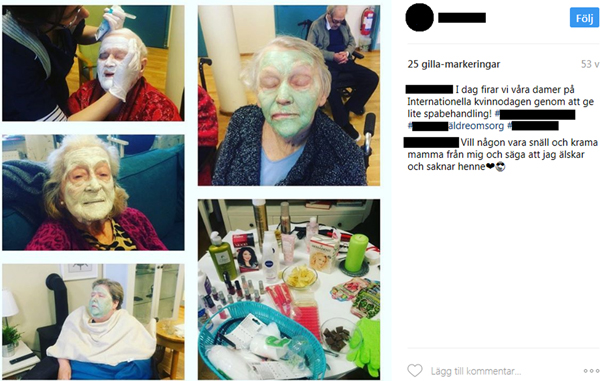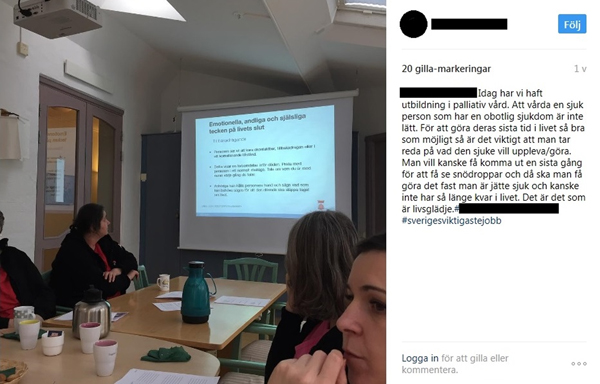Introduction
Many Swedish nursing homes have taken to posting photographs of their daily doings on Instagram. Instagram is one of the most popular social networking sites, primarily used to post images accompanied by short captions. In September 2017, the number of active users worldwide reached 700 million (Statista 2017). The nursing homes’ Instagram accounts show residents, members of staff and sometimes visitors supposedly going about their daily lives at the nursing homes. The captions are used for information about the occasion – who is in the picture and what they are doing. The situations differ from how nursing home life is traditionally portrayed: on Instagram, it seems genuinely happy and satisfying, with lively people engaged in activities together, going to cafés, art exhibitions or the beach, or eating strawberry cake to ‘celebrate everyday life’. The accompanying text is often emphatically positive, so that a photograph of a group of residents visiting a farm, smiling and cuddling dogs and horses, is captioned: ‘What a joy to breathe the fresh country air and meet the animals on the farm’. Sometimes the images garner comments from Instagram followers, which are similarly positive. Life as presented in the nursing homes’ Instagram accounts is conspicuously fun, active and sociable. There is not a hint of boredom, sickness, frailty or loneliness. Yet, according to the media and the literature, life in a nursing home is rather gloomy (e.g. Fiveash Reference Fiveash1998; Gustafson Reference Gustafson1972; Harper Ice Reference Harper Ice2002). The fact that the majority of residents are very frail plays a large part in this dreariness, and the institutional setting is also a significant factor.
Moving into a nursing home is traditionally regarded as evidence that one has officially entered the fourth age, a period of life marked by vulnerability, frailty and ‘the collapse of agency and personal identity’ (Higgs and Gilleard Reference Higgs and Gilleard2014: 10), to the point where Gustafson (Reference Gustafson1972: 227) has described it as ‘the ultimate failure in one's social career’. In Sweden, to be eligible for a place in a nursing home, the resident has to require extensive care because of their physical or cognitive impairments, and approximately one-third of all those who move to a nursing home die within a year of moving in (National Board of Health and Welfare 2016). The loss of physical ability and mobility is compounded by the significant increase in pain, poor balance and the risk of cognitive impairment caused by dementia that comes with advancing years (National Board of Health and Welfare 2014).
In addition to age-related decline, the individual has to deal with the atrophy associated with living in an institutional setting. A total institution, according to Goffman (Reference Goffman1961), is a place where the individual is deprived of their former roles and relations; stripped of possibilities to express their former individuality; isolated from society; subordinated to a hierarchal social order controlled by staff; and reduced and transformed to fit in with institutional practice. Numerous researchers have found similarities between Goffman's total institutions and nursing homes. As described by Lundgren (Reference Lundgren2000), nursing home life has been associated with estrangement, loneliness and passivity; a life revolving around sickness and impairment. The lack of autonomy within the institutional framework, combined with the physical or cognitive inability to carry out everyday activities, forces a learned helplessness and dependency on residents (Harper Ice Reference Harper Ice2002). Harper Ice (Reference Harper Ice2002) shows that nursing home residents spend two-thirds of their time in passive activities, but are engaged in social or expressive activities only about a tenth of the day. Since lack of activity is associated with decreased cognitive and physical function and lessened sense of control, this sort of passivity, encouraged by the institution, may result in further impairments (Harper Ice Reference Harper Ice2002). Gustafson (Reference Gustafson1972) describes how, long before biological or psychological death, society (staff, visitors, peers) forces the resident into a premature social death by terminating all efforts to maintain the resident's social life. Life in a nursing home thus carries the imminent threat of loss, whether it is a loss of autonomy, independence, familiarity, individuality, identity, social context, dignity or health (Cook Reference Cook2010; Harnett and Jönson Reference Harnett and Jönson2010; Lee, Simpson and Froggat Reference Lee, Simpson and Froggat2013; Riedl, Mantovan and Them Reference Riedl, Mantovan and Them2013; Schou et al. Reference Schou, Alvsvåg, Blåka and Gjengedal2008; Scourfield Reference Scourfield2007; Winterton and Warburton Reference Winterton and Warburton2012). Nursing homes are places which symbolise the ‘ultimate loss’ of personhood (Ryvicker Reference Ryvicker2006: 1).
Concerns about the detrimental effects of moving into a nursing home have been voiced by researchers and authorities, as have potential solutions. In dichotomous terms, the opposite of institutionality is often taken to be homelikeness (Lundgren Reference Lundgren2000), and great efforts are made to make nursing homes feel as homely as possible. Homelikeness is associated with familiarity, cosiness, security, freedom and self-determination (Lundgren Reference Lundgren2000), and may help preserve a sense of identity (Phenice and Griffore Reference Phenice and Griffore2013). In Sweden, rooms in nursing homes are officially regarded as flats, and can be furnished with the residents’ own furniture. Increased social and physical activities are encouraged in order to promote cognitive and physical health (Souto Barreto et al. Reference Souto Barreto, Morley, Chodzko-Zajko, Pitkälä, Weening-Djiksterhuis, Rodriguez-Mañas, Barbagallo, Rosendahl, Sinclair, Landi, Izquierdo, Vellas and Rolland2016; Kjøs and Havig Reference Kjøs and Havig2016), although Harper Ice (Reference Harper Ice2002) stresses the need for residents to be active also when not involved in structured activity programmes. The national fundamental values in elder-care was adopted in the Social Services Act in 2011, stating that older people should be able to live a dignified life in a state of wellbeing, aiming at ensuring their integrity and self-determination (SFS 2001:453 c 5 art 4). What Gustafson (Reference Gustafson1972) labels premature social death, meaning progressive separation from society, can be avoided if staff work to maintain the residents’ social lives. By striving for person-centred care and supporting residents’ choices, staff can maintain residents’ sense of control and individuality (Cook Reference Cook2010; Wellin and Jaffe Reference Wellin and Jaffe2004). Yet despite these efforts to handle the consequences of life in a nursing home, it is still the case that the media and official statistics paint a picture of nursing home life as one of mistreatment, loneliness, anxiety and depression (Jönson Reference Jönson2006, Reference Jönson2016; National Board of Health and Welfare 2016).
The proposed improvements imply that even though nursing homes are indeed institutions, there is a continuous ‘project’ on many levels which aspire to deinstitutionalise them. Whether by changing the architecture and furnishings, offering more activities or implementing new fundamental values, the overall aim seems to be to make nursing homes seem like something other than institutions. The present article focuses on one aspect of this project: public presentations of nursing homes as they appear on Instagram. Instagram is understood as a tool with which to manage the impression mediated to the public. Nursing homes, like all organisations, want a good reputation (see Power et al. Reference Power, Scheytt, Soin and Sahlin2009). External presentations (by the media, academics or state authorities) can entail a sense of vulnerability, since it deprives the organisation of the power to influence its reputation (Power et al. Reference Power, Scheytt, Soin and Sahlin2009). Instagram, a platform controlled by the organisations themselves, is in this article understood as a means by which the organisations can show themselves in a more favourable light, challenging the dominant image of nursing homes being sites of loss and decline. This article aims to examine how nursing homes present themselves through their Instagram accounts, and what kind of life they say they make possible. What kind of reality is put on display? How is this reality constructed using images and captions? And, crucially, what is excluded from the presentations?
Methods and data
The basis for any constructionist study is the idea that reality is not simply and inevitably ‘there’, but rather it is actively and continuously constructed and reconstructed by its participants (Gubrium and Holstein Reference Gubrium, Holstein, Holstein and Gubrium2008: 3). In line with this idea, the nursing home Instagram presentations are understood as examples of reality construction. The aim of the article is not to determine whether the Instagram presentations comply with what is actually going on at the nursing homes, but rather what kind of ‘nursing home reality’ is constructed through the Instagram accounts. The documentation that makes up the Instagram images and captions are understood here as products by which people construct and mediate their own view of themselves and reality, of those documented and of the audience (see Prior Reference Prior2003). The nature of the nursing home reality constructed and mediated to the public depends on the selections made – some things are put on display while others are not.
The sample consists of four nursing homes’ Instagram accounts, a total of 338 Instagram images. The study is part of a research project on nursing homes with specific profiles. Nursing home profiles can be based on ethnicity, language, religion, interests or ‘lifestyle’. The number of both municipal and private nursing homes that have adopted a profile has increased vastly in Sweden in the past decade. As it turned out, the profiles did not have any significant impact on how the nursing homes presented themselves on Instagram, so the profiles per se are not in focus here.
Two criteria were applied in the sampling process. The first was that the nursing homes should, by their own account, have a specific profile. The second criterion was that the nursing home should have an Instagram account that it used actively as a means of communication (meaning that images were posted at least every other month). An initial browse-through of websites of 15 municipalities across Sweden, as well as a commercial, online nursing home finder (Seniorval 2017), was made to gain information about which nursing homes met the criteria. Where the website information was insufficient, which was often the case, contact was made with nursing home managers by email or telephone. When choosing which Instagram accounts to include in the study, I aimed for variation regarding modes of operation (municipal or private), size of municipality, number of nursing home apartments, frequency of Instagram posts, and profiles. In a few cases I was not able to reach the managers of the nursing homes. These nursing homes were then excluded, since I was not able to obtain permission to use the Instagram images for research purposes. Finally, I selected four Instagram accounts which met the sampling criteria as well as gave breadth to the data (see Table 1). Despite variation regarding aforementioned factors, the initial analysis revealed that the same main themes recurred in all four accounts, therefore the collected data were judged to be sufficient. For the purpose of validation, I overviewed ten additional Instagram accounts and found that these accounts’ presentations were very similar to the findings presented in this study, therefore it seems unlikely that additional data would have changed the result of the study.
Table 1. Description of nursing homes and Instagram accounts

The data consist of images posted over the course of one year (March 2016 to March 2017), thus covering seasonal activities such as national holidays. The Arts nursing home's Instagram account presented a problem, as the vast majority of the images were of paintings done by the residents. Since this paper focuses both on activities (such as painting) and on how relations and places are presented, only every third image of a painting was included, whereas all the images depicting people, places or other activities were included. Videos were excluded from the data. Almost all the images had captions, which were analysed in conjunction with the images.
The Instagram images only portray residents who had consented to being in the picture and having the pictures publicly posted on Instagram, and in theory thereby available to all Instagram users. Permission to publish Instagram images in this article was obtained from the nursing home managers. All but one allowed the unrestricted use of their images, while the fourth withheld permission for images of residents who had died. All names in this article are fictitious. The four nursing homes are referred to by their respective profiles: Garden & Nature, Arts, Sports & Spa and Finnish.
Initially, the data were coded according to who was shown in the photographs, how relations between the participants were presented, where they were and what they were doing. Some images rendered several codes, such as a picture of residents from the Arts nursing home visiting an art exhibition, which was then coded as both ‘Activity: Profiled’ and ‘Outside the nursing home’ (Table 2).
Table 2. Images of nursing home activities on Instagram
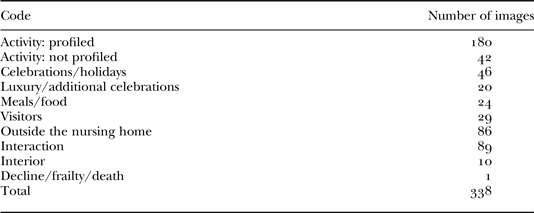
The initial coding showed that life in the nursing homes was centred on activities, often together with other residents or staff members. Life seemed to follow a ‘normal’ seasonal cycle, celebrating holidays such as Christmas or being outdoors in summer (see Nirje Reference Nirje1994). All nursing homes presented themselves as interacting with the wider community by going on excursions or inviting guests to the home. Exceeding the ‘normality’, all nursing homes also displayed moments where residents were shown enjoying additional celebrations or ‘life's little luxuries’ – a grand Nobel Day dinner, a karaoke night on a weekday or a spa treatment on a rainy day.
The second stage of the analysis was guided by the question of what general message the Instagram images was communicating to the audience. This question seemed best answered by not only analysing the images, but also by considering what was not presented on Instagram. As Prior (Reference Prior2003) argues, the choice of what to present and what to exclude from any type of documentation says a great deal about what kind of reality the authors or senders are trying to convey. What was absent from these images were social death and loss of personhood – the ultimate failure – along with idleness, boredom, loneliness and passivity. Even care activities, which are frequent enough occurrences in a nursing home, were very rarely visible on Instagram. In short, things that might remind the viewer of institutional life and decline were missing. The starting point of the analysis is therefore the ways in which the nursing homes’ Instagram images relate to the traditional image of nursing homes being places of loss and decline; and if the message conveyed is that these nursing homes are not institutions, then what are they?
Analysis
Human service organisations provide individuals with identities. Organisational frameworks for understanding individuals and their problems mean that human service organisations descriptively produce people (Holstein Reference Holstein1992). Whether a social services client, hospital patient or nursing home resident, the institutional categorisation and management of the individual's assumed needs and problems ensure a reduction of the individual (Järvinen and Mik-Meyer Reference Järvinen, Mik-Meyer, Järvinen and Mik-Meyer2003; see also Magnússon Reference Magnússon and Eliasson1996). In places where patients, clients or residents spend all their time – total institutions, in other words – the institutional identity will challenge, and sometimes even replace, the former sense of self. Goffman (Reference Goffman1961: xxi) describes total institutions as places of ‘residence and work where a large number of like-situated individuals, cut off from the wider society for an appreciable period of time, together lead an enclosed, formally administered round of life’. Such settings, he claims, entail the loss of autonomy and self-determination for the people who live there, to the point where personhood is eroded. Thus, living in a total institution causes not only a transformation, but a reduction of the individual.
Swedish residential elder-care has undergone considerable changes over the last century. The large institutions where old and poor lived together with orphaned children and people with mental disorders or addictions (Edebalk and Lindgren Reference Edebalk, Lindgren and Eliasson1996) have given way to the ‘homelike’ nursing homes of today. In the last decade, the government has further stressed the importance of enabling residents to live dignified lives and to exercise self-determination (Ministry of Health and Social Affairs 2009) in order to make nursing homes feel like ‘home’ and to counteract the worst of the reducing effects of these total institutions. Certainly, to judge by the Instagram accounts, the traditional nursing home is a thing of the past. Nursing home life seems to be sociable, active, meaningful, fun and even luxurious – quite the opposite of the monotonous and reducing life described by Goffman. The analysis identified four main themes in the ways the nursing homes presented themselves and the life they made possible: (a) life is active and sociable, (b) life is normal, (c) life is more than before, and (d) life in interaction with society.
Life is active and sociable
The basis for nursing home life, as presented on Instagram, is that it is active and sociable. All but a very few of the images show residents participating in some form of organised activity. This contests the idea of life in a home being predominantly idle, with residents passively watching television, lying in bed or simply doing nothing (see Harper Ice Reference Harper Ice2002). On Instagram, the role of being a nursing home resident is portrayed as being involved in fun activities, often with others, and to be active, sociable and content with life. Similarly, many of the images are of staff and residents joining in such activities together. In one example (Figure 1), four people are dancing in pairs. The couple at the front are looking at each other, smiling. It is not immediately obvious from the photograph whether the people in the picture are staff, residents or visitors. The caption reads, ‘Some of the [nursing home] residents didn't just sing, they also wanted to dance. Believe it or not, people had such a good time with the karaoke programme that the staff had to carry them out after 2½ hours???’ Indeed, almost all images have captions, the vast majority designed to enforce a positive interpretation of the images. Here, the viewer is informed that the dancers are having ‘such a good time’ that they did not want to stop dancing. In a similar way, residents are assigned positive feelings, opinions and experiences – they are happy, having fun, enjoying themselves, having a wonderful time or ‘beaming as bright as the sun’ – reinforced by a slew of positive emotional words: sunny, tasty, delightful, lovely, successful, refreshing, lively, pretty, sweet, good, nice.
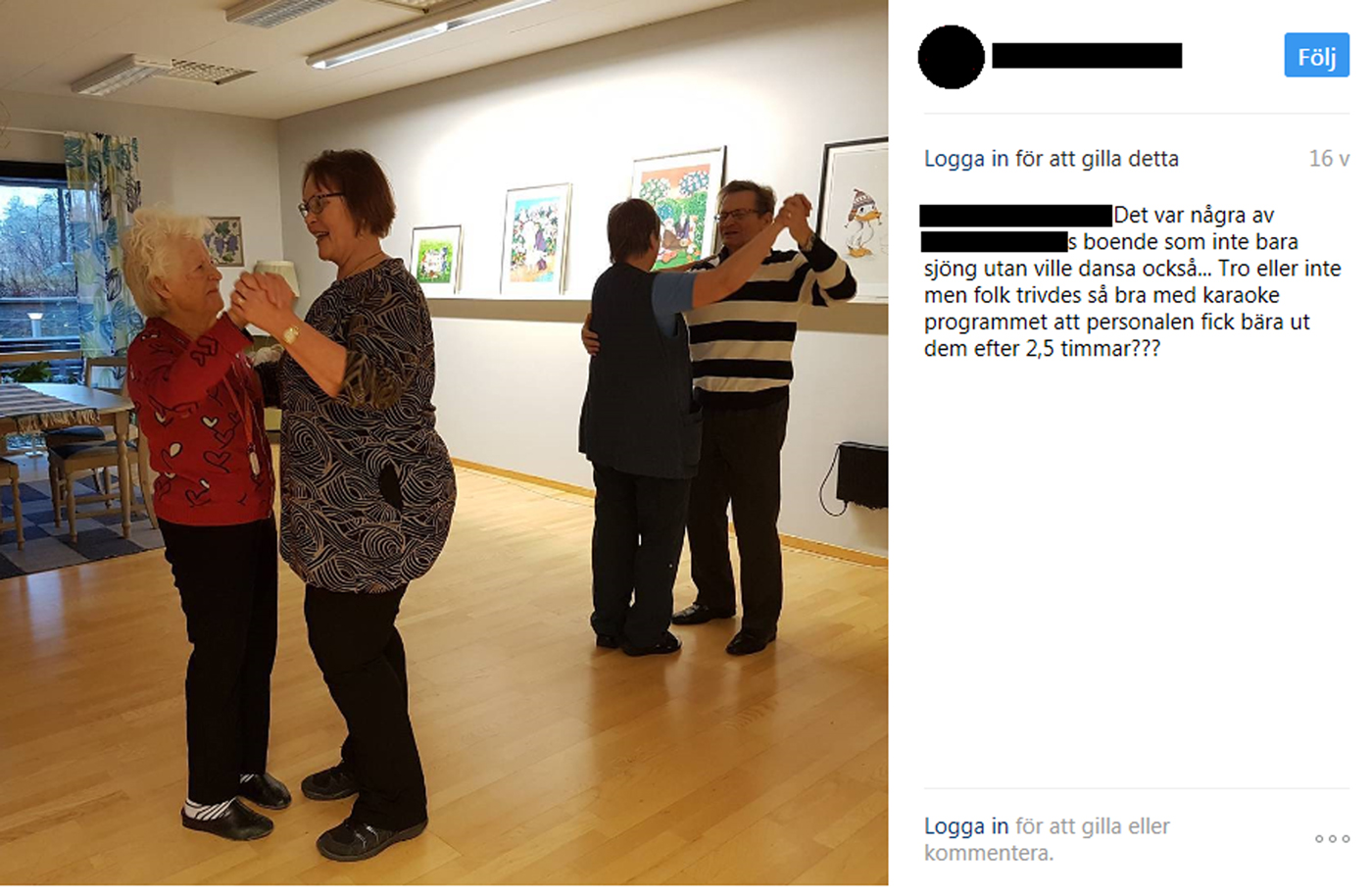
Figure 1. People having a good time dancing.
In addition to showing people having a good time, most images of staff and residents show them engaged in an activity together, as opposed to something being ‘done’ by one party to or for the other: staff and residents eat ice creams in the sun, they sit at a café table together or ride a duo bike together. Many of the captions describe the people in the picture as a ‘we’. ‘Greetings from us’; ‘Today we celebrated Gustav's birthday’; ‘We were accompanied on our walk’; ‘We painted still lifes’; ‘We played Mölkky [throwing game] as long as the weather let us’: none make a clear distinction between staff and residents, portraying them instead as friends or acquaintances. Their roles as care-givers and care recipients do not determine the terms of their participation or their relations to others in the group. Erlandsson (Reference Erlandsson2014) has analysed how the roles of being a care-giver and care recipient are presented on care providers’ websites. She concludes that the images in her study present the two groups very differently, for instance, in images of younger hands holding older hands, thus displaying staff offering support and comfort to worried or lonely older people. Had the Instagram images displayed situations centred on care activities (e.g. dispensing medicines or helping residents eat), the divide between staff and residents might have been more prominent, but, apart from staff pushing residents in wheelchairs, such images are wholly absent from the Instagram accounts. Instead, relations are displayed as ‘private’ rather than institutional, with members of both categories participating on equal terms (see Harnett and Jönson Reference Harnett and Jönson2017). Thus, the images display the very opposite of what Goffman (Reference Goffman1961: 17) claims characterises the total institution, namely a daily life structured by an enforced ‘sequence of activities being imposed from above by a system of explicit formal rulings and a body of officials’ – institutional hierarchal roles and asymmetrical relationships.
Another form of relationship shown as being central to nursing home life is relations between residents. If the individual is indeed stripped of former roles and relationships on moving into an institution, and the barriers between the institution and the outside world entail a loss of social context and accustomed social order (Goffman Reference Goffman1961), then separation from the individual's former group context will threaten their relational and social identity (Tajfel and Turner Reference Tajfel, Turner, Austin and Worchel1979; Vignoles, Schwartz and Luyckx Reference Vignoles, Schwartz, Luyckx, Schwartz, Luyckx and Vignoles2011). The Instagram images challenge the idea of such potential threats and losses. One shows two residents, a woman and a man, sitting together at a table. The woman has put her hand on the arm of the man, and both of them are smiling, leaning in towards each other and looking into the camera. The captions reads: ‘Today Sven and Marianne, among others, joined in playing bingo. Marianne and Sven became friends when they met here at [the nursing home]. It goes to show that you are never too old to make new friends’. The message draws on both the age of the two residents and where they live: neither factor entails a loss of any kind, according to the caption. Instead, the nursing home is said to provide the residents with the opportunity to make new friends, framing it as not a place of loss but rather as a place where one can gain social relations.
The way the bingo is presented is interesting in itself. Bingo is usually thought of as a traditional nursing home activity. According to Kracker et al. (Reference Kracker, Kearns, Kier and Christensen2011), it is one of the most common activities offered in nursing homes. Thus, bingo might be associated with the traditional nursing homes, in turn, associated with institutions, decline and loss (Hostetler Reference Hostetler2011). Since the Instagram accounts are to all intents projects designed to signal ‘non-institution’, it must be trickier to flag images of bingo as ‘non-institutional’ compared to images of residents eating ice cream in the sun or getting a spa treatment. This dilemma was often resolved by framing bingo as an extra fun activity. The captions proclaim that this is ‘a favourite activity’, ‘the most popular activity’ or ‘Today we're doing what we like the most – BINGO!’ Against the backdrop of bingo being a potentially ‘institutional’ activity, these ways of presenting bingo can be interpreted as accounts (see Scott and Lyman Reference Scott and Lyman1968). It seems important to convey that the residents do in fact enjoy playing bingo. The captions, together with photographs of concentrated or smiling residents filling out their bingo cards, announce that even though bingo might be a standard nursing home activity, it is much appreciated by residents, and nothing to do with mundane, traditional nursing home life.
Life is normal
In Swedish law, the basic principles of elder-care are self-determination and normality (Ministry of Health and Social Affairs 2017). Nirje (Reference Nirje1994: 19) defines the normalisation principle as enabling people to ‘obtain an existence as close to the normal as possible’. A normal life is considered the opposite of an institutional, reduced life. Although normality can mean many things, one aspect is experiencing the normal rhythm of the week and, more generally, the year. Marking the changing seasons, celebrating national holidays and other significant days, making weekends a little bit special: all of this can counteract an otherwise monotonous institutional life, where all days blur into one. In this sense, normality is an everyday life that resembles the patterns of mainstream society (Nirje Reference Nirje1994).
Normality is displayed on all the Instagram accounts. The rhythms of a normal year are marked by images of holidays, birthdays and other significant moments, and the props used are visually typical of Swedish customs and traditions: the photograph of a crayfish party is of a group of residents and staff at a table with white tablecloths, with a spread of food and drink typical of a crayfish party (crayfish, cheese quiche, salad and schnapps) and the traditional paper lanterns and garlands. All these accessories contribute to a presentation which resembles how most Swedish crayfish parties are orchestrated. Easter is portrayed with pictures of Easter eggs, vases of twigs decorated with colourful feathers, a cake with marzipan chickens and ‘Happy Easter’ on top, and bunches of daffodils, again, all in keeping with Swedish tradition. All Saints’ Day shows a table covered with lit candles; Midsummer's Eve, a strawberry gateau; National Day, the Swedish flag and balloons: all of them Swedish customs with the props, the food or decorations that are in line with what Swedes would say should be there. The nursing homes do not deviate from the established forms of celebration, and it seems it is important that their adherence to tradition is obvious to the viewer. Again, the images signal the normality of the nursing home life.
Normality is also presented in images of residents engaged in typically seasonal activities. Thus, the Sports and Spa Instagram account has numerous photographs of residents going to the beach in the summer. One (Figure 2) shows two women sitting by the sea having just had ice creams (according to the caption). It echoes what many Swedes would think of doing on a sunny day, given the chance: going to the beach, enjoying the fine weather, eating ice cream. Life in the nursing home does not seem so very different to life prior to moving in or life outside. In this way, nursing homes are presented as places which enable continuity of life, or which provide the opportunity to live life as it should be lived. This kind of normality is displayed a great deal in the Instagram images. The Garden & Nature Instagram account shows a woman in a wheelchair outdoors, seemingly enjoying some winter sun (judging by the bare trees in the background); the Finnish Instagram account shows two people (it is unclear if they are residents or members of staff) holding buckets, bending down to pick lingonberries and blueberries in an autumn forest; the Sports & Spa Instagram account shows two residents in wheelchairs, parked in front of the television, eating crisps, drinking wine and watching the European football championships.

Figure 2. Out and about.
Food is often used to signal a normal weekly rhythm, at least when displaying how weekends are made a little bit more special, such as a picture of a smörgåstårta (a savoury sandwich cake), with the caption saying ‘Getting into the Friday mood at [the nursing home]’. In another image, a woman is sitting at a table, holding out a glass and a folded napkin to the person taking the photograph. There is a vase of flowers and streamers on the table, and the caption reads ‘We went to town laying the table today! After all, it's Sunday!’
Together, the images create an impression that nursing home residents are living lives much like people in general do. While their everyday is not the same, their weeks and years bear a close resemblance to normal weeks and years, with their normal variations. On Instagram, nursing homes are places that do not hinder normal life.
Life is more than before
Several images skirt normality altogether to show how everyday life is made special, even luxurious. These images seem not to aim to convey normality or homelikeness, neither do they signal institutional life. Instead, they give the impression that there is always something to celebrate; fun or special moments are scattered throughout daily proceedings in the nursing homes. Institutional life may be dull and routinised (Goffman Reference Goffman1961), but, on Instagram, nursing home life is good and can get even better.
An image in the Sports & Spa account depicts three women – one staff member and two residents – sitting at a table with bottles of nail polish and a nail file. The caption reads: ‘Wet weather! We're having a cosy day in with massages and manicures.’ There are numerous examples of such little luxuries, conveying special occasions sprinkled on the everyday life: the Arts account overflows with photographs of residents going to museums and art exhibitions; the Finnish account shows residents singing karaoke on a Wednesday evening; the Garden & Nature account has a picture of a strawberry gateau and the caption ‘We're celebrating everyday life!’ Sometimes, captions are used to frame seemingly ordinary activities as something out of the ordinary: hence the picture of a woman in a supermarket aisle, looking into the camera with a faint smile. She is in a wheelchair, her handbag in her lap, holding a chocolate bar, with the caption ‘Today Alma has been on a shopping spree in [the supermarket] :)’. Going to the supermarket is reframed as going on a shopping spree; indulging in the (assumed) joys of consumerism.
Another way of displaying how nursing home life is given a gilt edge is by showing celebrations of notable or special days. The Sports & Spa account describes nursing home residents eating apple pie to celebrate Apple's Day, eating cinnamon buns to celebrate Cinnamon bun's Day or getting spa treatments to celebrate International Women's Day (see Figure 3). Although these days are usually not considered fun and festive occasions by Swedes in general, the Instagram accounts signal that the nursing homes make the most of them. The Nobel Day dinner parties are a case in point. In one example (Figure 4) there are tables laid with white tablecloths, candles, fronds of ivy, folded napkins, golden confetti, and plates and cutlery for both main course and dessert. The rooms seems large, grand even: in one there is a chandelier, and in the background a grand piano and a fireplace. The caption says: ‘Preparations for tomorrow's Nobel Prize dinner in the different wings [of the home].’ In another photograph, taken on Nobel Day (10 December), seven residents are sitting at a table, plates filled with food, raising their wine glasses towards the camera. The caption says: ‘We at [nursing home] say cheers and celebrate Nobel Day with a delicious dinner.’ The overall impression from the images is that the day is associated with splendour.
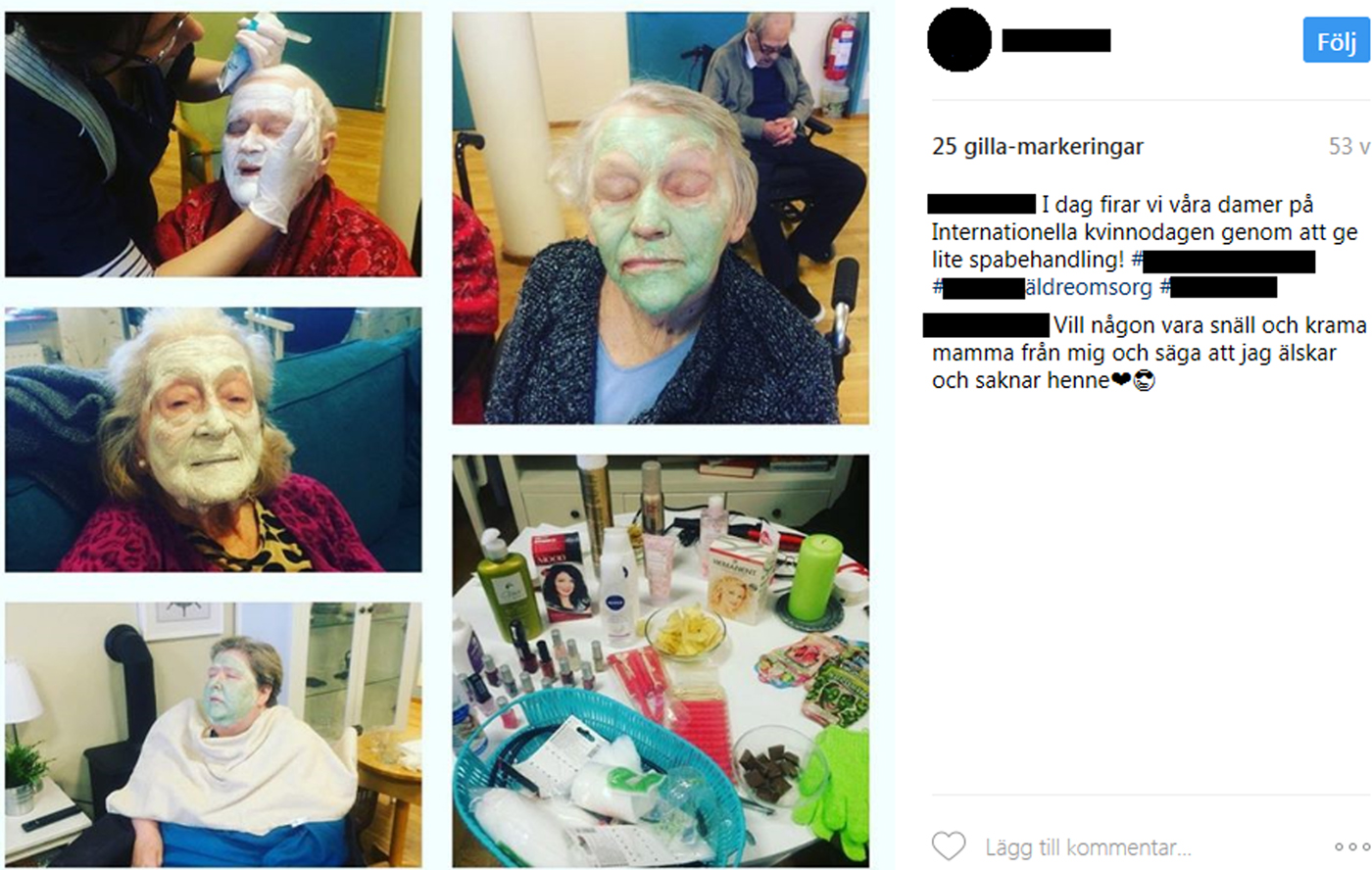
Figure 3. Residents getting spa treatments.
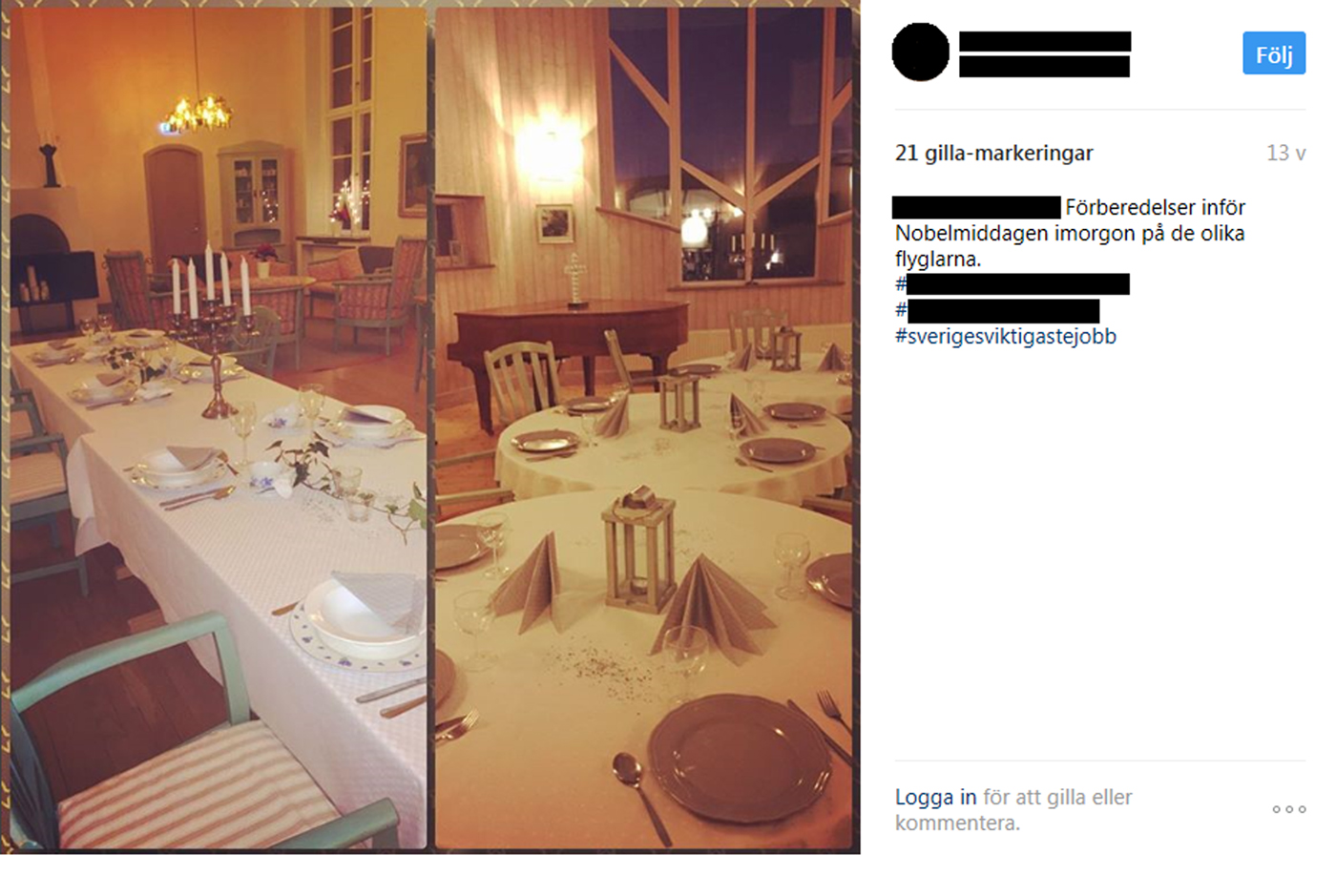
Figure 4. Preparations for a Nobel Day dinner.
Pictures of Nobel Day celebrations are not unusual on nursing homes’ Instagram accounts; however, marking the Nobel Prizes in this way is unusual for most Swedes. This is not a homelike or normal celebration (unlike Christmas or Easter), nor is it institutional. The photographs of Nobel Day celebrations often convey a sense of solemnity, and seem to be used to signal that nursing homes do not only celebrate the ‘usual’ holidays, but rather they seize every opportunity to celebrate. In another image from the Sports & Spa nursing home, some of the residents are getting spa treatments. The image comprises five photographs in one (see Figure 3): four of women having facials either sitting in wheelchairs or on a sofa, and one of a table covered in beauty products. In the top left image, a staff member applies the face mask to one of the residents. The overall impression is that the four women are relaxed and are enjoying being pampered in this ‘spa-like’ manner. The table with the beauty products adds to the general spa-likeness, as does the caption: ‘Today we celebrate our ladies on International Women's Day with some spa treatments!’ It should be noted that in images such as this, the relations between staff and residents are no longer the equal ‘we’. The ‘we’ in this image plainly refers to the staff, who were celebrating ‘our ladies’ by giving them spa treatments, making it clear who is supposed to give and who is supposed to receive such (luxurious) care.
The man in the background of the top right photograph is worth noting. He is sitting in a wheelchair, apparently asleep or looking down at his hands, and not taking any interest in the activity. One must assume that the woman in the foreground was the photographer's subject, chosen to display an occasion of pleasure and luxury. The man's apparent idleness might bring to mind the passivity and boredom that were the characteristics of an institutionalised nursing home life. Thus, he presents a small crack in the carefully constructed glossy surface.
Such cracks are very occasionally seen in other photographs, and of these one image in particular stands out (Figure 5). It may have been posted to demonstrate that nursing home life is subject to continuous improvement, but it also shows that it is a place where people are very sick, and where they die – and depicts an occasion where these matters are very much in focus, when sickness, death or even care activities are wholly absent from all four Instagram accounts. In the photograph, four members of staff are sitting at a table, two of them looking at a PowerPoint projection. Only the heading of the slide is visible, saying: ‘Emotional, spiritual and mental signs of an approaching end’. The caption says: ‘Today we had a course in palliative care. It is not easy to care for a sick person who has an incurable disease. To make their last days of life as comfortable as possible, it is important to find out what the sick person wants to experience/do. Perhaps they want to get out one last time to see the snowdrops and they should be able to, even if they are very sick and might not have long left to live. That is what joy of life is about’. Even though there are no terminally ill residents in the picture, it is clear that improving their care is the aim of the course, making this image the only one to touch on the subject of death and dying. The message is that this nursing home is always striving to improve, and that it is possible to ensure residents find ‘joy of life’ even when dying – although, perhaps unintentionally, the image is also a salutary reminder of the realities, contrary to the otherwise solid construct that nursing homes are not places of decline and death.
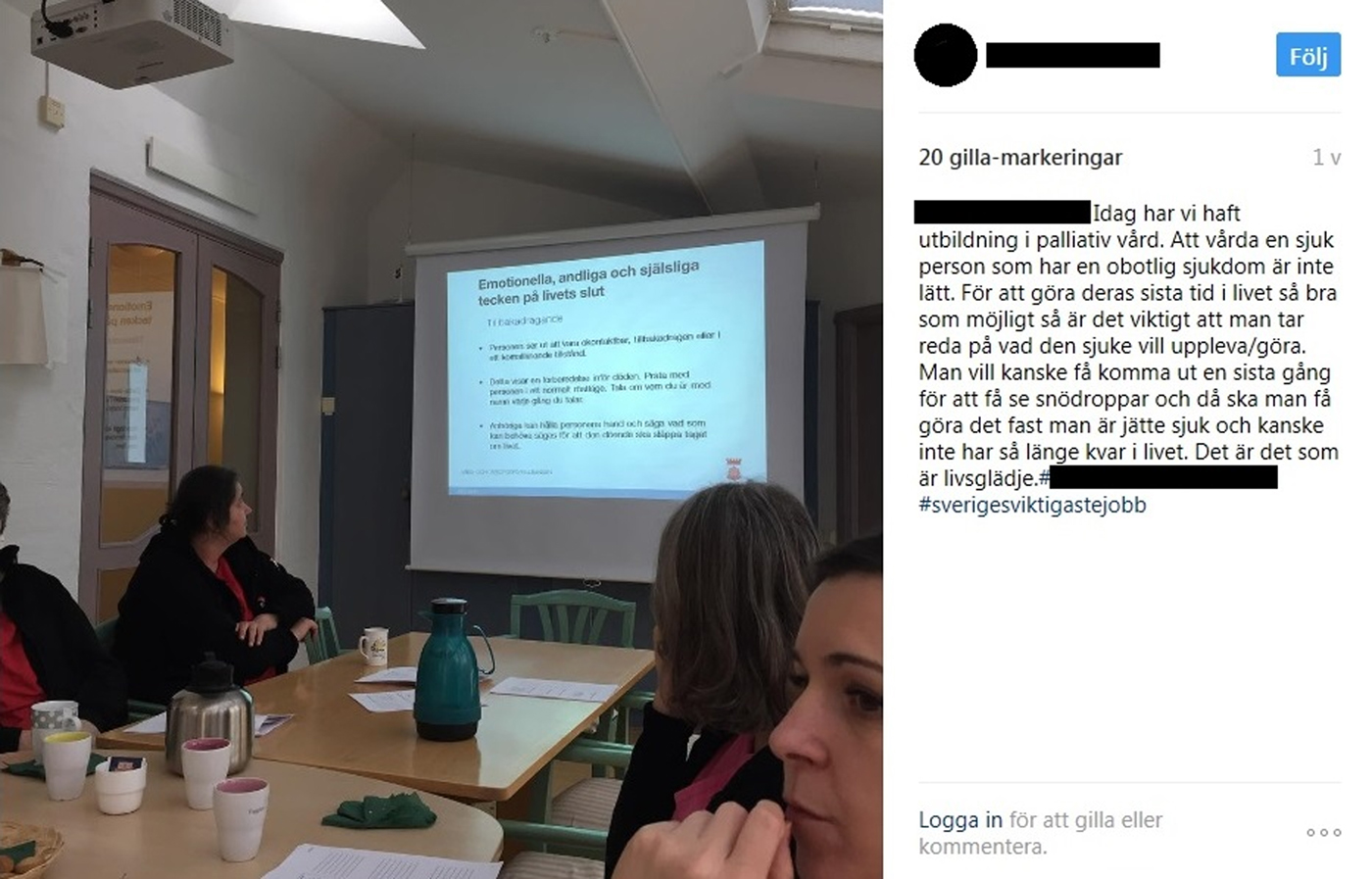
Figure 5. The sole reminder of death and dying among all the Instagram images. The heading of the slide reads: ‘Emotional, spiritual and mental signs of an approaching end’.
Life in interaction with society
On Instagram, the nursing homes are not isolated places. If the barrier between the outside world and the institution is the first violation of personhood, entailing a loss of the roles and self-understanding acquired before moving into the institution (Goffman Reference Goffman1961), then it is not evident in the Instagram images, for about a third of them show residents out and about or people visiting the nursing homes. The Arts Instagram account, for example, has both, with photographs of residents going to art exhibitions and of visitors to the nursing home to see the art made by the residents.
Consider the image of a woman sitting in a wheelchair in front of the entrance to an art exhibition (Figure 6). The sign above the door in the background announces the exhibition to be ‘Monet to Cezanne: The French Impressionists’. The woman is smartly turned out in a necklace, earrings and lipstick. The caption says: ‘Hugs to children and grandchildren and great-grandchildren from Julia’, and a heart emoji. The image signals that being a nursing home resident is no obstacle to taking part in life outside the nursing home – one is not isolated. Judging by the woman's appearance, this seems to have been a special occasion, another indication that this was perhaps one of life's little luxuries, as described above.
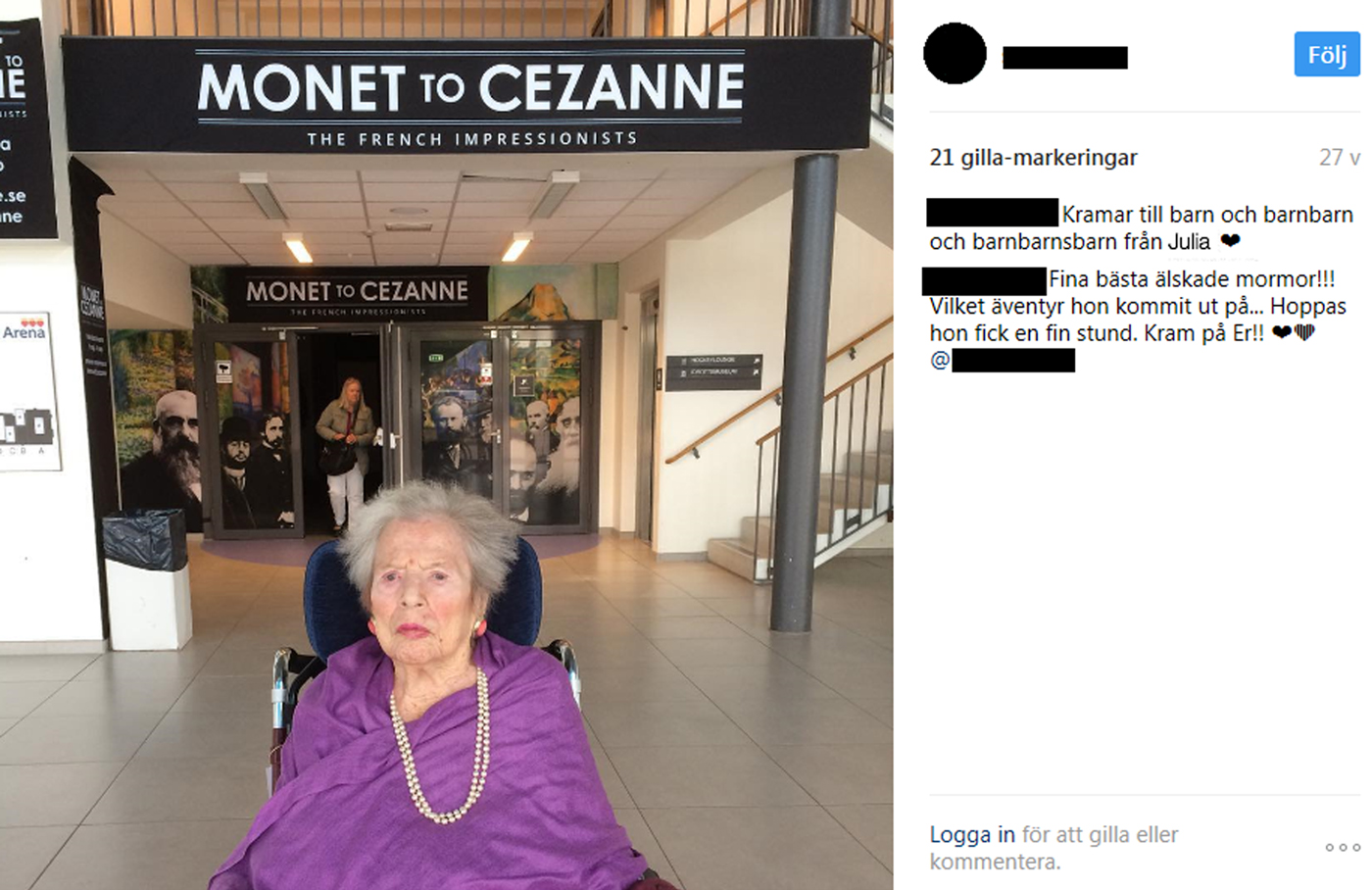
Figure 6. A trip to an art exhibition.
The images on the Arts Instagram account of residents outside the nursing home are exclusively of visits to art-related locations, such as museums or art exhibitions. The Garden & Nature Instagram account is more diverse in the places visited; however, the excursions do not seem to be in line with the nursing home's profile. For example, there are images of residents visiting a staff member's farm, seemingly happily petting horses and cuddling a dog. Another shows two residents at a football match, with captions describing the joy of rooting for one's favourite team. Yet another image shows a group of residents having lunch at a restaurant followed by what the caption says was a guided tour of a castle. On the Sports & Spa Instagram account, almost half of the images show residents outside the nursing home – given that it is only a few minutes walk from the sea, it is unsurprising so many of the images show walks along the shore, most often in sunny weather.
In one such image (Figure 2), two women in wheelchairs are half-turned towards each other as if in conversation, with their backs to the photographer (who presumably is a member of staff). One of them has a small dog on a leash. It is sunny and probably warm, judging from how the women are dressed. Beyond them is a breakwater, and behind it the sea and blue sky. The women seem unaware that a photograph is being taken, giving the impression that they are not posing for the camera, and that the way they are sitting, looking out at the sea, is ‘natural’. The caption reads: ‘Today we took a stroll down to enjoy the sea, eating delicious ice cream on the way.’ Although it is not possible to see the women's expressions to gauge whether they were indeed enjoying both the weather and each other's company, the caption is certain that they were, emphasising the delightfulness of the moment.
Many images of the nursing homes also show visitors: relatives, lecturers, musicians who have come in to entertain residents, or children trick-or-treating at Halloween. One picture from the Garden & Nature Instagram account shows a smiling Buddhist monk, with the caption: ‘Today we granted one of our resident's wishes. A monk paid a visit and they got to talk about life.’ In other images too, guests, like excursions, are said to have been requested by the residents, framing these activities as expressions of self-determination.
All in all, both the images of residents out and about and of guests visiting the nursing home convey the message that nursing homes are sites of interaction with the surrounding world.
Discussion
The traditional image of nursing home life has for the most part been associated with the loss that comes from living in an institution, and with it anxiety, depression, loneliness and helplessness. On Instagram, the typical characteristics of the total institution are absent, and nursing homes present themselves as non-institutional. One might assume they would attempt to move further towards what is commonly understood to be the opposite of institution, namely homelikeness, and that is partly the case: the Instagram accounts display normality in the weekly and yearly rhythms shown, nursing home residents are presented as being in interaction with the surrounding world, and that relations in the home are friendly and personal rather than remote and formal (see Hartnett and Jönson Reference Harnett and Jönson2017), with the lines between staff and residents often blurred, referring to staff and residents as a ‘we’, and centred on activities rather than care. Nevertheless, a more prominent element in the Instagram accounts is life depicted as more than before. Situations and occasions that exceed normality are often the subjects of Instagram posts – manicures, eating strawberry gateau on a weekday, meeting new friends, dancing and having fun, having a Nobel Day dinner and other festive moments – nursing home life is constructed as a matter of improving rather than maintaining the daily life of the residents. Whereas homelikeness usually denotes continuity, on Instagram nursing home life is about development, emphasising the nursing homes’ offer of more. The nursing homes present themselves as neither institutional nor homelike, but as going beyond the usual dichotomy; as places where everyday life is sociable, active and fun, interspersed with luxurious and festive moments; places where one can live life to the full.
I would argue that the Instagram presentations should be understood as constituting counter-arguments in relation to the traditional discourse of nursing homes as institutions. The awareness of the popular notion of what nursing homes are like guided what was to be included and excluded in order to make a convincing counter-argument (see Prior Reference Prior2003). In Prior's (Reference Prior2003) words, images convey notions of frozen factuality about different phenomena. Like other forms of documentation, they serve to provide proof that the situations depicted did in fact occur. The overall message from the Instagram images seems to be: ‘We know that you think that nursing homes are places of loss and decline, but look at this and think again!’; and as a reality construct it must be regarded successful. The few minor exceptions, such as the seemingly idle man in the background of the spa image, are easily discounted in the otherwise solid construction of non-institutional nursing homes on Instagram.
While it makes sense from this perspective for as many institutional features as possible to be excluded from the Instagram accounts, it is not clear why frailty, sickness, death and care activities should also be excluded. One reason might be that since the presentations concentrate on an active, sociable and fun life, the images generally show residents involved in activities in communal areas or interacting with the outside world. The fact that there are no photographs taken in the residents’ own flats automatically excludes those who are too frail to leave them (see Harper Ice Reference Harper Ice2002). It is also likely that the platform itself affects how nursing home life is portrayed. Since Instagram provides for public comments on images, it might be less likely that a nursing home would choose to post ‘sensitive’ images, such as images of visibly sick or frail residents, for ethical reasons or fear of negative feedback in the comments. Public negative feedback would damage the organisational reputation (Power et al. Reference Power, Scheytt, Soin and Sahlin2009). Yet, although it should be possible to display ‘successful’ care activities without putting their reputation at risk, as Erlandsson (Reference Erlandsson2014) shows, care is excluded from the presentations.
The image presented on Instagram bears no relation to the traditional, gloomy picture of nursing home life. Yet rather than being proof of what nursing home life is like, the Instagram presentations might be understood as what Alvesson (Reference Alvesson2006: 29) identifies as a key trend in contemporary organisations, namely acts of illusion: conveying positive images or ideas is equally, if not more, important than what is ‘really’ going on in the organisations. Presentations of a phenomenon, such as nursing homes, become part of the phenomenon itself. Prior (Reference Prior2003) even claims that the phenomenon reported on is performed through the products of documentation. The Instagram nursing homes are places where life is fun and active, relations are friendly, and residents are content and vital. These presentations stand in stark contrast to reports claiming that nursing home residents experience loneliness, anxiety and depression to a greater degree than old people who do not live in residential or nursing homes (National Board of Health and Welfare 2016).
Thus, nursing home life seems to be the subject of two discourses: a gloomy one and an idyllic one (Jönson Reference Jönson2016). What, then, does the idyllic presentation of nursing home life have in the way of influence? Online presentations offer the opportunity to manage the impression mediated to the audience. Instagram, like other forms of social media, constitutes a platform where individuals and organisations present themselves in a way which corresponds to what they believe the audience desires; self-presentations are goal-oriented and strategic (Smith and Sanderson Reference Smith and Sanderson2015; see also Goffman Reference Goffman1959). The very nature of Instagram entails that what is put on display is carefully selected, providing a polished impression, and the nursing homes’ Instagram accounts are no exception. Since the number of Instagram users is steadily growing, and social media is having an increasing impact on our perception of countless things – brands, countries, political parties, celebrities, even ourselves (see Filimonov, Russmann and Svensson Reference Filimonov, Russmann and Svensson2016; Linné Reference Linné2016; Newman Reference Newman2015; Serafinelli Reference Serafinelli2015) – the Instagram presentations may help to change the way we perceive nursing home life. When it comes to personal use of social media, like individuals posting pictures of their daily lives, it is common-sense knowledge that what is presented online usually is a selection of all the things that happen offline (see e.g. Serafinelli Reference Serafinelli2015). The audience is aware of this due to the fact that they share similar experiences of what ‘everyday life’ contains. However, as few of us have personal experience of what a nursing home is like, we must rely on second- or third-hand information. The audience might, therefore, be more inclined to buy into the rosy images provided by the nursing homes’ Instagram accounts. Moreover, as we ourselves might become nursing home residents in the future, perhaps we simply do not want to credit the dreariness of nursing home life as long described by researchers, the authorities and the media, and would rather imagine it to be fun and social, and residents to be active and happy, at the same time as we are outraged when hearing about mistreatments (Jönson Reference Jönson2006).
The efforts to challenge the traditional idea of what nursing home life is like could be considered an attempt to combat ageism, to show that old people too can be happy and active. Yet the consequence might be the opposite, for not even in a palliative context are old people ‘allowed’ to experience loss and decline, or be in need of extensive care. Nursing home residents are exposed to society's expectation that they will continue to live a third-age life, even to the very end. By concealing the residents’ decline, the stigma attached to the fourth age becomes even more apparent. If one cannot be sick and frail when dying, then when?
Acknowledgements
The study was carried out as part of the research programme ‘Individual Care and Universal Welfare: Dilemmas in the Age of Marketisation’. The author wishes to thank Tove Harnett and Håkan Jönson for valuable comments. The author also wishes to thank the two anonymous reviewers for useful comments. The study was funded by the Swedish Research Council for Health, Working Life and Welfare (FORTE, Grant Number 2013–2296). The study was approved by the Regional Ethical Review Board in Lund, Sweden (Grant Number 2015/864).






